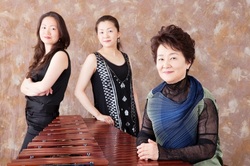
And so it was with the Fujiis: a Japanese family of percussionists consisting of mother Mutusko, and daughters Haruka and Rika. They were joined by Canadian artists – percussionist Scott Ryan, pianist Gregory Oh and the Toronto Children’s Choir – in a program of Japanese and Canadian works.
Sisters Haruka and Rika were joined by Ryan and Oh for Carousel, a premiere by Montreal-based Michael Oesterle. Scored for glockenspiel, vibraphone, marimba and piano, Carousel was gloriously resonant: a glittering jangle of colour, a something like an Indonesian gamelan. In his program notes, Oesterle described the ensemble he selected as akin to a prepared piano without the intrusive hardware. Thanks to the rhythmically solid playing of the four musicians – closely grouped together, like a string quartet – the goal of four instrument mingling into one was achieved with deft elegance.
If Carousel was a little bit Indonesian, Claude Vivier’s Pulau Dewata was overtly influenced by its composer’s exposure to gamelan music. Vivier wrote the piece in 1977, a year after he visited Bali – and the title means “island of the gods” in Indonesian.
Vivier’s publisher, Boosey & Hawkes, describes the work as scored for “variable ensemble.” On this occasion, the Fujii sisters, Ryan and Oh used the same instruments called for in Carousel, plus a set of chimes. For this reason, despite differences in character and Affekt – Pulau Dewata was solemn and ritualized where Carousel was festive and playful – there were strong timbral similarities. Also, the same kind of tight ensemble-work from the players made for yet another effective performance.
After close-knit sonorities of Carousel and Pulau Dewata, Toru Takemitsu’s Seasons was a dramatic contrast. For this piece, four percussionists (all the Fujiis and Ryan) were positioned around the hall, for a “surround-sound” effect. As well, Seasons called for an array of mostly unpitched percussion instruments – drums, gongs, cymbals, shakers, claves, temple-blocks, rain-sticks, and many others. Sitting in the darkened hall, with percussive clicks, whirs and shimmers coming from all directions was a fascinating and otherworldly “soundscape” experience. It was like a night in a jungle – but a jungle on some other planet.
The second half of the program began with Maki Ishii’s Hiten Seido II, for two marimbas, a showpiece brilliantly played by the Fujii sisters.
And it continued admirably, with the arrival onstage of the Toronto Children’s Chorus. The fine choir, well prepared and led by conductor Elise Bradley, sang Hotaru Koi by Ro Ogura, and Yamagara Diary and Letters to God by Akira Miyoshi.
The first work was a nice a cappella display, with some cute lighting effects done with flashlights. The two Miyoshi works were accompanied, with more marimba pyrotechnics from Rika Fujii – and also with a set of stone bells called sanukite, played by Mutsuko Fujii. (They sound something like a celesta on steroids.)
However, I can’t say that I found any of these pieces as musically compelling as the repertoire performed before intermission. Most of it was merely pleasant.
© Colin Eatock 2013
 RSS Feed
RSS Feed

